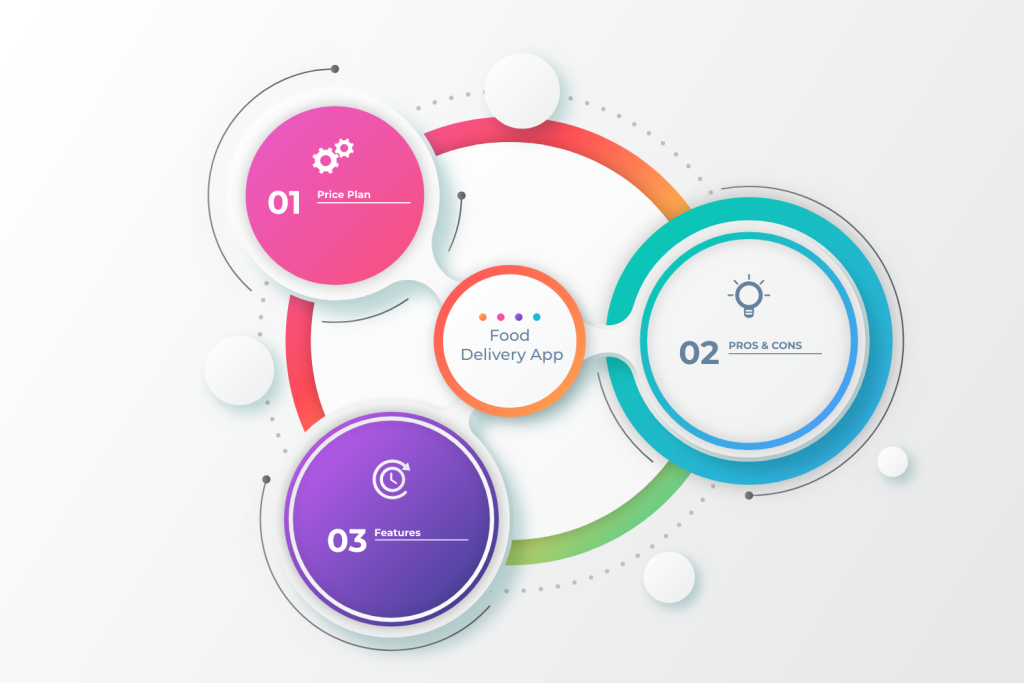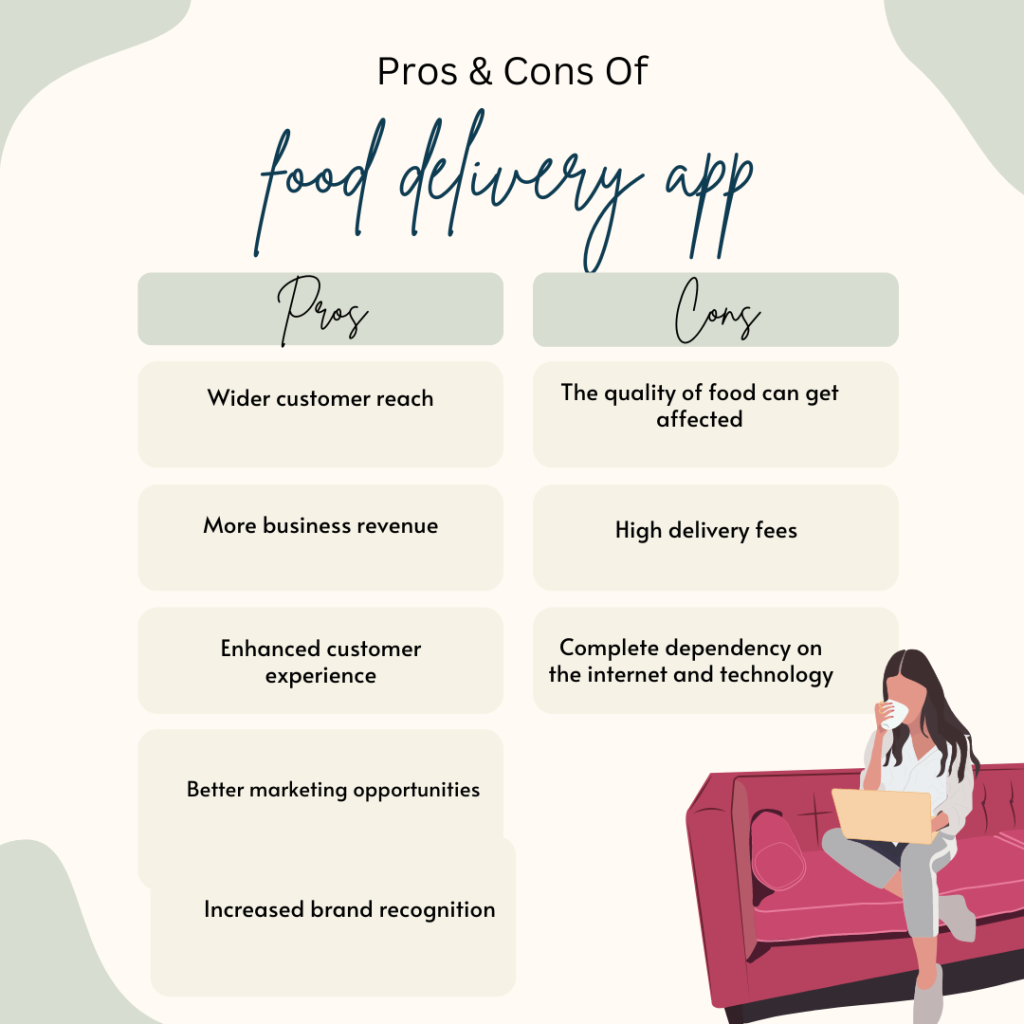The demand for food delivery apps is on the rise. With customers demanding faster and more reliable services, on-demand food delivery apps have become a must for businesses in the food industry. As a result, the online food delivery market is expected to reach about 400 billion mark by 2027. The numbers prove that online food delivery’s future is bright, and it is the right time for entrepreneurs to invest in it.
Before you begin with food delivery app development, understanding the concept and trends in-depth is essential. This blog will discuss the price, pros, cons, and features of the food delivery app.
Let’s begin with understanding how much it can cost you for on-demand food delivery app development.
Pricing of food delivery app development
Pricing is a crucial factor for businesses to consider during app development. Especially for startups and small businesses, ensuring that food delivery app development is done within their budget is a top priority.
On average, the cost of food delivery app development can vary between $15,000-$60,000. For those looking to optimize their budget while ensuring high-quality app development, considering to hire flutter developers can be a cost-effective and efficient solution. The price varies so much based on the platforms you choose, the development team location, the tech stack used, and the skills and experience of the app development team.
Further, there are various pricing models for the development of the food delivery app. These include:
- Fixed-price model: The model is based on a pre-defined project scope and budget. Before beginning the project, the development team provides a fixed price for the complete project and completes it within that.
- Hourly model: Also known as the time and material model, it is based on actual time spent by the app development team on the project. The team bills the client for the number of hours worked and materials used.
- Hybrid model: The model is a mix of the above two pricing models. The development team provides a fixed price for the core features and a flexible rate for additional features or changes as requested by the client.
Pros of food delivery app
As a food business, you must be aware that there is a rising customer demand for food being delivered at home. With giants like Uber Eats and Zomato, customers’ expectations have risen even more, and they always look for better services. Integrating your business with a food delivery app can help achieve these targets quickly and efficiently.
Some of the pros of food delivery apps for the business include:
1. Wider customer reach
With a restaurant or cafe, you may only attract local customers. Only people who live nearby or know about your services will visit the place. On the other hand, a food delivery app will widen this reach. For instance, the audience who cannot come to your place can register to the app and place the order.
2. More business revenue
Every business wants a better return on their investments. For the food industry, building a food delivery app can help with it. With the support of the food delivery app, you will receive more orders, leading to higher revenue. Hence, it will enable you to cover wider areas for food deliveries and get better returns for the same.
3. Enhanced customer experience
Eatery outlets’ primary focus is to provide their customers with a seamless experience. With a food delivery app, it can be achieved in the best way possible. The users can easily browse the menu, search for the dishes or their favorite restaurants, place orders, and get real-time updates for all their orders. Did you know that 33% of consumers say that they are ready for a higher fee for faster delivery and better service?
4. Better marketing opportunities
With the best food delivery app, there is always a chance for better marketing. It provides a platform for restaurants to promote their menu and services. On the other hand, it also helps brand admin promote discounts and offers to attract more customers and enhance user retention.
5. Increased brand recognition
What other best way there is than to promote the brand digitally? With the on-demand food delivery app, businesses can enhance brand recognition by promoting it to a larger audience. Further, it will establish a strong brand image and increase customer loyalty.
Cons of food delivery app
While food delivery apps offer a range of advantages to the business, it also has some drawbacks.
1. The quality of food can get affected
Who doesn’t enjoy that hot food served on the plate? Unfortunately, when customers order their food through an app, it tends to get cold, spoiling the customer experience. Also, late deliveries and poorly handled food can spoil the quality and experience.
2. High delivery fees
One of the biggest disadvantages of on-demand food delivery is the higher delivery charges. In addition to the food cost, customers also have to bear the delivery cost. The price is estimated based on the distance to be covered. Hence, those ordering from a far distance have to suffer the most.
3. Complete dependency on the internet and technology
Food delivery apps operate entirely on the internet and technology. Therefore, areas that have poor internet connectivity will face trouble using these applications. Further, technology can lead to security breaches and hacking.
Features of the food delivery app
Features and functionalities in the food delivery app are what make it outshine the market. Hence, during food delivery app development, one must ensure to add all the necessary features. Further, apps will be required for the user, service provider, delivery agent, and admin. Hence, features for all should be separate to ensure a smooth functioning and seamless experience.
Let’s look at the top-notch features you must add to the app.
User app
- User registration and login: The app should first enable users to easily register with their phone number, email, or social media accounts.
- Menu browsing: The food delivery app solution should also allow users to browse the restaurant menu and filter by cuisine, dietary preferences, price, and other factors.
- Order placement: Order placement should be a hassle-free process on the app. Users must be able to place an order and specify the delivery address and payment method.
- Real-time order tracking: The food delivery app should also let the users track orders in real-time and receive push notifications on their progress.
- Payment integration: As with every order, customers will have to make a payment; the process should allow them to do it with various methods like credit/debit cards, online banking, and mobile wallets.
- Ratings and reviews: Each user should be able to rate and review the restaurant, their food, and the delivery services the agent provides.
Admin app
- Restaurant management: The app should let the admin manage the list of registered restaurants, their menus, pricing, and availability.
- Order management: Admin should also have access to manage the list of orders, assign it to delivery agents, and track its progress.
- Payment management: Thirdly, the app must enable the admin to manage the payment gateway, process refunds, and generate reports.
- User management: Further, the app admin must also be able to manage the list of registered users, their profiles, and preferences.
- Analytics and reporting: Lastly, they should be able to access analytics and reports on sales, revenue, and other vital metrics.
Service provider app
- Restaurant acceptance: Service providers should be able to accept or reject incoming orders from users through the app.
- Order management: The food delivery app should enable the service providers to manage the assigned orders, view their details, and update the order status.
- Navigation: The app must also allow them to use GPS navigation to reach the delivery address without any problem.
- Earnings tracking: Further, the restaurant owner should also be able to track their earnings, view payment history, and withdraw payments.
Delivery agents app
- Order management: Firstly, delivery guys should be able to manage the list of assigned orders, view details, and update the order status.
- Navigation: Secondly, the food delivery app should empower delivery agents to use GPS navigation to reach the delivery address.
- Earnings tracking: Thirdly, the delivery person should be able to track their earnings, view payment history, and withdraw payments when they want.
- Ratings and reviews: Fourthly, delivery agents should receive user ratings and reviews based on their service.
Key takeaway
The points mentioned in the above sections are a must to consider before you get started with app development. Now that you are clear regarding the concept of a food delivery app, you need a reliable food delivery app development company that can help you build the best app.



